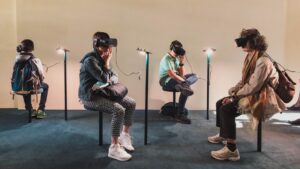Amazing VR Headset Statistics That Prove It Is Here to Stay
Virtual reality is the future (VR Headset). There are no two opinions about that. It’s rapidly infiltrated every aspect of our entertainment lives in the past few years — from gaming and movie-watching to professional sports training, VR has changed the world we live in. Virtual reality statistics are equally mind-boggling and…
Wait a second.
I’m getting ahead of myself.
First things first…
What is VR?
VR tech (which stands for virtual reality technology, in case you missed it) uses computer technology to create a simulation of an immersive experience. This simulation can be anything — from a wondrous fantastical environment, to your parents’ basement. VR is always accompanied by a head-mounted display (HMD), which (in part) makes all that magic possible (VR Headset).
What is VR like?
Think of VR as being kind of like the Matrix but in a duller, more 21st century style. You can walk in meadows and mountains, fight with fantastical creatures, or go on a virtual tour of Machu Picchu, for examples. With the headset on, you become completely immersed in the simulated reality that is projected for you — both by image and sound.
How many VR games are there?
Plenty. There are 500+ games just for PlayStationVR alone!
You might be wondering now — is this all that VR is good for? Shooting pixels in high definition and immersing yourself in a hyper-realistic world?
Actually, that’s not quite the case. In recent years VR and AR (augmented reality) have found a more practical usage… in nearly every industry out there. The healthcare market, education, business… you name it. Given VR’s limitless interactivity, it can be used to teach, train medical personnel and test prototypes with significantly less risk than the real deal. How neat is that
Virtual reality statistics 2021 [that BLEW my mind away]
- The global VR and AR markets combined are forecast to amount up to 209.2 billion USD by 2022
- China invested $593 million in VR technology between 2015 and 2016
- 78% of Americans are familiar with using VR technology
- Gaming and entertainment services account for 50% of total VR market share
- 14 million AR and VR devices have been sold in 2019
Let’s dig into these (and more) fascinating virtual reality facts into the following paragraphs. Let’s start with the fact that…
1. The global VR and AR markets combined are forecast to amount up to 209.2 billion USD by 2022
(Source: Statista, Greenlight Insights)
Do you know what was the size of the combined VR and AR market in 2018? No? Make a guess…
…
It was estimated to be $27 billion. Not great, but not terrible, right? To put this number into perspective, you should know that there are around 1 billion AR users in 2021. However, virtual reality market growth is expected to increase 7.7 times by 2022 — to reach the whopping number of 209.2 billion USD. Can you imagine? Not even Kylie Jenner has that much in her bank account — maybe she should have invested in the VR global expansion instead of makeup…
2. China invested $593 million in VR technology between 2015 and 2016
(Source: GlobalMe)
If you think the US is the biggest player on the virtual reality hardware market, you’re wrong. The US is the second best guess, because they are losing to the winner – China.
Step back from popular VR headsets such as PlayStation VR and Oculus Rift — and make way for Mi VR, courtesy of Xiaomi. This headset was sold out the very first day it came out in December 2016, which can give you a good overview of the Chinese virtual reality market size.
Interestingly enough, a large majority of this $593 million investment in the technology in China comes from… the Chinese government. It is part of their “Internet plus” initiative, which wants to encourage businesses to march on toward digitalization and using modern technologies.
3. 78% of Americans are familiar with using VR technology
(Source: Greenlight Insights)
Let’s play another guessing game. Knowing (assuming you read this section’s title!) that 78% of Americans are familiar with VR now, can you guess how many Americans were familiar with VR back in 2015?
45%. No tense pauses here — I will let that 32% increase over just 5 years speak for itself. I am guessing it won’t be long before the whole world has converted to VR — what a time to be alive!
Media contributes greatly to these positive virtual reality trends — you can thank movies like Ready Player One for that. The VR elements in viewability of major sports events (like the Super Bowl and the Winter Olympics) also played their part in spreading the good word.
4. Gaming and entertainment services account for 50% of total VR market share as of 2019
(Source: 3D Insider)
It makes sense that VR and gaming go hand-in-hand… or is that just me?
Even though gaming is not a big deal when we are talking about VR headset sales, it becomes a very big deal when we are discussing VR software sales. Making up 50% of the market share, which amounts to around $30 billion (in 2019), VR gaming is a force to reckon with. In the future, VR game sales are only going to go up. In fact, 64% of VR users are certain that gaming is the business that has most to gain from the growth of VR technology.
Who’s to say what lies ahead in game innovation? Will we finally be able to play a fully-immersive VR lifelike experience of the Witcher 3? Who knows, who knows…
5. 14 million AR and VR devices have been sold in 2019
(Source: CCS Insight)
In 2018, the unthinkable happened — there was a decline in virtual reality devices sales. The year marked only 8 million devices sold, which wasn’t great, considering the 10 million units sold in the previous year. However, that appeared to be just a small hiccup, as sales soared in 2019 — reaching 14 million devices!
This rise in sales is expected to gain even more momentum in the future. Virtual reality statistics predict that by the end of 2022, the number of sales will reach 52 million units. If you want to talk about money, this translates to $8.5 billion market value in 2022.
Not too shabby, eh?
Virtual reality industry statistics
1. 171 million people use VR technology today
(Source: Statista, Market Watch)
Given that there are 14 million Head-Mounted Displays sold in 2019, it’s no wonder that the number of people using VR is also considerable. Namely, 171 million people worldwide.
This is a fascinating stat, considering that the jump between 2017 and 2018 was 90%! VR adoption rate marks a steady growth as 35% of surveyed business executives say they adopted AR or VR technology into at least one business unit. It’s also worth noting that 16 million out of the 171 million worldwide users identify themselves as either innovators or hardcore gamers. As for the rest — they are early consumers of various kinds.
2. There is an expectation of 98.4 million sales by 2023 in VR
(Source: Forbes)
Predictions for VR are brighter than my future — VR sales projections worldwide are expected to hit 98.4 million by 2023, generating an installed base of 168 million units and a 2% worldwide population penetration. All countries are getting into VR and China is steady in leading the way (VR Headset).
As 5G is also coming soon to your friendly neighborhood network, the hopes for future virtual reality progress are higher than ever. The experience is expected to be more accessible, steady and immersive. Perhaps this leap in technology will further increase the ever so rapid evolution of virtual reality (VR Headset).
3. VR-related job openings in the gaming industry increase by 93%
(Source: Indeed)
With so much going on in the VR world it’s no wonder that jobs in this sector are soaring. 17% of the growth happened during 2017-2018, as well as job openings, mainly came from the VR software companies: game designers, producers, programmers and artists to use VR Headset, as well as business and sales professionals.
The golden goose for gaming in VR came with Apple’s ARKit, as well as Google’s ARCore, and things haven’t been the same since. According to AR statistics, these two handy pieces of hardware made it easier to integrate games specifically to be more AR/VR suitable with VR Headset.
And which are the biggest VR game developers in the US, you might be wondering? New York City’s Rockstar Games takes the first place, followed by Activision Blizzard and Naughty Dog from LA and Popcap Games from Seattle.
So, in case you were ever wondering: “How much does a virtual reality designer make?”, the answer to that question is — a lot.
4. VR arcades are slowly becoming an important part of the gaming industry
(Source: Viar 360)
VR technology is still quite expensive. Many consumers are hesitant to make a purchase, as they aren’t sure it would be justified. Will they like it? Will they play enough? What if it gets boring?
Enter VR arcades.
Similarly to what happened in the 80’s, VR arcades nowadays contribute to a positive feedback loop, where arcade players feed the industry, which in turn produces cheaper consoles, which in turn attract more players. Don’t think I am making this up – VR arcades have contributed to a major rise in total gaming VR industry growth — $286.7 million in 2018 to be exact. After all, it is much cheaper to spend $25 for 30 minutes of VR extravaganza at the arcade, than to buy a $400 virtual reality full set. Just saying.
5. The number of installed virtual reality headsets is estimated to grow to 37 million by 2021
(Source: Statista)
This rapid expansion of virtual reality adds up to an estimated 37 million VR units sold by the end of 2021. Remember how some paragraphs ago I told you that there were 14 million devices sold in 2019 — this is more than a 60% increase in sales!
Let’s do a quick roundup on the evolution of VR headset usage:
- 2015 – 2.9 million devices
- 2016 – 7 million devices
- 2017 – 10 million devices
- 2018 – 8 million devices
- 2019 – 14 million devices
- 2020 – 37 million devices
Talk about a positive VR market forecast! Maybe by 2025 all of us will have their own individual headset at home…
Virtual reality user statistics 2021
1. Only 14% of VR device purchases are made by women
(Source: The Brief Blog)
Oh come on, you aren’t surprised that the VR demographics are dominated by men, right? A 2016 report, that studied 4 million Americans, found that only 14% of the online VR hardware buyers were women (VR Headset). Of course, this is a study from 4 years ago and it is very likely that this number has changed!
Women make up 44.6% of online shoppers for console, mobile and PC games. It looks like they are pretty much established in the gaming world — but maybe they just aren’t that interested in VR… yet. My guess is that after VR usage rises even more, women will be able to find creative ways to utilize that power — and rule the world.
2. 51% of Generation X and 45% of Baby Boomers want more travel-based VRs
(Source: Global Web Index)
Older generations aren’t that interested in the gaming implications of VR — they want to travel instead! The virtual reality industry is very versatile and provides a playground where anyone’s aspirations can be fulfilled. Want to visit Cuba or go snorkeling in Australia from your living room? This doesn’t sound so crazy anymore.
VR has interesting implications for travel marketing as well. It can allow travelers to sample an experience (like flying a helicopter or getting a virtual tour of the Egyptian pyramids) before actually committing to it. This once again proves the point that virtual reality software offers endless possibilities in exploring the world around us — not just through games.
3. User experience is the main obstacle to wider VR adoption
(Source: Statista)
According to 27% of surveyed respondents, user experience is the only thing preventing a global VR boom. Issues like technical bugs, glitches and uncomfortable headsets frustrate people and prevent them from enjoying the technology to the fullest.
However, comparing current data to virtual reality(VR Headset) user statistics 2018, when this number was 41%, there is an obvious positive trend of these VR statistics. Other points of improvement that users pointed out were the customer and business hesitation (20%) and the poor content quality (19%).
4. More than 60% of parents think that VR can be educational for their children
Augmented Reality Statistics 2019
Ok, enough about VR — let’s take a peek into AR territory. What is AR you might ask? Well, it’s VR’s less sophisticated cousin.
Augmented reality technology adds digital elements to reality, by using a camera viewfinder or a smartphone display. Now that we are on the same page, get ready for a few awesome augmented reality stats.
2. AR gaming market is predicted to gain $284.9 billion by 2023
Speaking of Pokémon Go, you should know that the game contributed around $1.2 billion to AR growth. Considering this, it’s no surprise that experts predict a potential AR market revenue of $284.9 billion by 2023. What’s more, the overall AR gaming industry marks a compound annual growth rate of 152.7% for the period between 2017 and 2023.
If this confuses you, let me make it simpler for you – these numbers are huge! They also further cement the statement that AR is going places…
3. 88% of mid-sized companies are already using AR in some capacity
(Source: Deloitte)
Not just applicable to gaming, AR has proven itself to be a champion in other fields as well. One of these fields is the corporate sector — AR looks very promising in terms of marketing and customer service. In fact, many mid-market companies (annual revenue between $100 million and $1 billion) are experimenting with AR to help their business.
This experimentation can be seen in statistics for AR worldwide. Mobile AR ad revenue (think Snapchat and Facebook) is expected to exceed $2 billion by 2022. A true game changer!
In Conclusion
So, where do you see virtual reality in 10 years? What technical advances will the industry make? Will it be better user experience and produce more travel content? What kind of innovative VR and AR games will come to the market next? I don’t have the answers to these questions, I can only speculate but one thing’s for sure — the VR industry will continue to grow.
Virtual Reality Predictions
But still, how is VR going to evolve in the coming years? Well, predictions are that virtual reality growth will depend on the quality of stories told to its audience. It is also very likely that VR will further penetrate the health, business and education market. Rehabilitation is one interesting field to look at in terms of medicine and the technology can also cultivate stronger empathy in terms of journalism and communication.
Because of the superior quality of virtual reality graphics, people can experience thrilling documentaries in a whole different light.














Leave a Reply